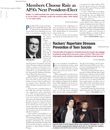The Centers for Disease Control and Prevention tracks the pulse of the world's health from its main campus in Atlanta. The agency was born there almost 60 years ago, when malaria still stalked the southeastern United States.
Its predecessor was the former Office of Malaria Control in War Areas, established during World War II to research and control the disease. Once malaria was eradicated in the United States in 1951, the unit's mission was broadened to include typhus and other maladies, and the name was changed to the Communicable Disease Center. That gave it the unshakable three-letter acronym (CDC) that has stuck ever since despite morphing into the present Centers for Disease Control and Prevention in 1992.
The CDC's job is to “promote health and quality of life by preventing and controlling disease, injury, and disability.” True to its roots, the agency is probably best known for its work in tracking, studying, and preventing infectious diseases. The Epidemic Intelligence Service began in 1951 and became a training ground for physicians and others drawn to public health. Its members have traveled from remote African villages, looking for Ebola virus, to Midwestern church suppers, cataloging salmonella poisoning. Along the way, they've helped with the eradication of smallpox and polio (almost) and the discovery of new diseases like Legionnaire's, hantavirus, and HIV/AIDS.
“The CDC grew out of being focused on infectious diseases, but it's now a much broader public health agency,” said Georges Benjamin, M.D., executive director of the American Public Health Association. “There's a new focus on bioterrorism and disasters, especially in regard to vulnerable populations.”
Eleven centers or programs fall under the CDC's umbrella, covering everything from birth defects to chronic-disease prevention to injury prevention to environmental health.
“The CDC plays an important role in collecting data to validate both the incidence of disease and its reduction,” said Benjamin.
A glance at the National Center for Health Statistics Web site confirms the range of the center's coverage, from A (Accidental/Unintentional Injuries) to W (Wyoming)—no X, Y, or Z, apparently. Somewhere in the middle is Mental Health, with such information as: “percent of noninstitutionalized adults with severe psychological distress in the past 30 days: 3.0 (2002)” and “number of visits to office-based physicians for mental disorders: 40 million (2002).” The full reports, of course, go into more detail.
There is a mental health component to other aspects of the CDC's work, such as preventing interpersonal violence and suicide. Agency staffers also work with counterparts at the Substance Abuse and Mental Health Services Administration on mental health issues concerning disaster preparedness and response, said Benjamin.
For all the CDC's work, more could be done, he said: “Its role has grown and so have expectations. We think the CDC budget could be doubled, just to properly fund the work now being done and to increase research and preparedness.”
Visitors to Atlanta who want to learn more about the CDC's history and present work can visit the Global Odyssey Health Museum, near Emory University. A tour of the museum includes a five-minute orientation video, followed by exhibits detailing the agency's history and current work. A self-guided-tour brochure is available in 14 languages. For groups of 10 to 60 persons, the museum can arrange for a volunteer CDC employee to provide a guided tour at 9:30 a.m., Monday through Friday, or 1:30 p.m., Monday through Thursday. Depending on the elements of the tour selected, tours take 45 minutes to two hours.
The museum is adamant that all visitors must make advance reservations to visit.
Additional information about the CDC, including making appointments to visit, is available by phone at (404) 639-0830 or online at<www.cdc.gov/global/email.htm>.▪
